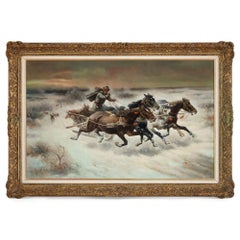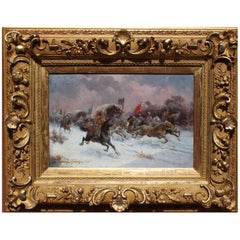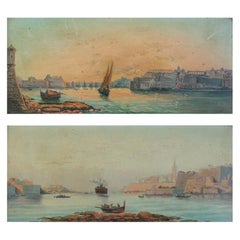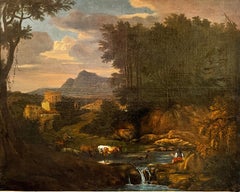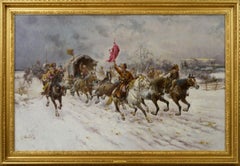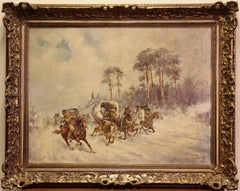Adolf Constantin Baumgartner-Stoiloff Art
to
1
1
1
1
1
Russian oil painting 'The Chase' signed C. Stoiloff
By Adolf Constantin Baumgartner-Stoiloff
Located in London, GB
Russian oil painting 'The Chase' signed C. Stoiloff
Russian, early 20th Century
Frame: Height 84cm, width 122cm, depth 7cm
Canvas: Height 66cm, wi...
Category
20th Century Old Masters Adolf Constantin Baumgartner-Stoiloff Art
Materials
Canvas, Oil
Adolf Constantin Baumgartner Stoiloff Oil on Board Cossacks Warriors on Horsback
By Adolf Constantin Baumgartner-Stoiloff
Located in Los Angeles, CA
Adolf Constantin Baumgartner Stoiloff (Austrian/Russian, 1850-1924) a fine oil on board "Charging Cossack Warriors on Horseback" within an ornate giltwood frame, circa 1890
Born in 1850 in Linz (Austria) Stoiloff died in Vienna in 1924. According to a research of Russian literature, he studied in the 1880s at St. Petersburg Imperial Academy of Fine Arts. He was very well known for his Russian horse...
Category
Late 19th Century Russian Baroque Antique Adolf Constantin Baumgartner-Stoiloff Art
Materials
Gesso, Canvas, Giltwood, Paint
Related Items
Pair of Oil on Board Harbour Scenes Manner of Luigi Maria Galea
Located in Ottawa, Ontario
Manner Of Luigi Maria Galea (1847-1917)
circa 1900
The Grand Harbour, Valetta, early morning; and The Grand Harbour, Valetta, at dusk
signed illeg...
Category
Early 20th Century Italian Grand Tour Adolf Constantin Baumgartner-Stoiloff Art
Materials
Paint
Huge 18th Century Italian Old Master Oil Painting Figures & Animals Arcadian
Located in Cirencester, Gloucestershire
The Arcadian Landscape
Italian School, 18th century
oil painting on canvas, unframed
canvas size: 32 x 40 inches
condition: excellent condition for its age, fully restored.
provenance: from a private collection in Paris, France.
Large scale classical 18th century Italian Old Master...
Category
Early 18th Century Old Masters Adolf Constantin Baumgartner-Stoiloff Art
Materials
Canvas, Oil
$10,937
H 32 in W 40 in D 1 in
Shepherd with Sheep, Cows and a Goat in a Landscape by Jan Frans Soolmaker
Located in Stockholm, SE
This painting depicts a pastoral scene that is attributed to the artist Jan Frans Soolmaker, an artist known for his Italianate landscapes and scenes that often feature equestrian and Arcadian elements. The painting is not signed but is attributed to Soolmaker, relating it to a known signed work by the artist that was sold at Sotheby’s London in 1999.
The scene is suffused with the warm glow of a setting or rising sun, casting a soft light that is characteristic of Soolmaker’s landscapes. It shows a shepherd guiding a group of cattle across a shallow stream, with the animals taking center stage in the composition. The animals are rendered with careful attention to their forms and the play of light on their bodies, which is a hallmark of Soolmaker's work. The landscape is composed of a rocky terrain with trees and shrubbery, creating a sense of depth and natural beauty that invites the viewer to explore the scene further.
The background suggests a vast, open landscape with distant mountains, which adds to the Italianate feel of the painting. The sky is dramatic, with clouds catching the light of the sun, contributing to the overall serene yet dynamic atmosphere of the work.
The provenance of the painting is notable, having been in the possession of significant historical figures such as Swedish Prince Fredrik Adolf, and later The collection of Pär Ulmgren, The collection of Gösta Stenman, and Engineer and politician Gustaf Henry Hansson.
Potential buyers have the option of choosing between a newly made gold frame or an older brown frame, which allows for personalization in how the work is presented.
Soolmaker’s work is often compared to that of Dutch painter Nicolaes Berchem, whose style he emulated. Soolmaker's landscapes reflect a similar sensitivity to light and composition, making his works sought after for their beauty and historical significance. Despite the smaller body of work left by Soolmaker, due to his short career, his paintings are valued for their craftsmanship and the legacy of the artist’s brief but impactful contribution to the Dutch Italianate landscape genre.
Information:
Jan Frans Soolmaker (Flanders 1635‑1685)
Shepherd with Sheep...
Category
17th Century Old Masters Adolf Constantin Baumgartner-Stoiloff Art
Materials
Canvas, Oil
$4,323 Sale Price
20% Off
H 22.05 in W 20.87 in
Landscape Near Felday, Surrey
By Abraham Hulk the Younger
Located in Hillsborough, NC
Dutch/English artist Abraham Hulk the Younger (1851-1922) is most known for landscapes of the British countryside. This work is one of a pair (the second work is also available by s...
Category
Late 19th Century Old Masters Adolf Constantin Baumgartner-Stoiloff Art
Materials
Canvas, Oil
$1,960 Sale Price
30% Off
H 27 in W 22.75 in D 2.13 in
Antique Framed Impressionist Oil Painting on Board
Located in Houston, TX
Antique framed impressionist oil painting on board.
Lovely artist signed antique framed impressionist oil painting on board. This beauty d...
Category
1920s Barbizon School Vintage Adolf Constantin Baumgartner-Stoiloff Art
Materials
Masonite
Period Marine Landscape Credited to Warren Sheppard
By Warren W. Sheppard
Located in Roma, IT
This beautiful painting, due to its very high quality of execution, style and era, can be referred to the great artist Warren Sheppard, who specialized in seascapes.
Of great evocati...
Category
19th Century Old Masters Adolf Constantin Baumgartner-Stoiloff Art
Materials
Canvas, Oil
$3,362
H 15.75 in W 21.46 in D 2.76 in
Large Traditional Dutch River Landscape with Old Town & Houses Signed Oil
Located in Cirencester, Gloucestershire
Landscape in Holland (titled verso)
Dutch School, 20th century
signed oil painting on canvas, framed
framed: 30 x 42 inches
canvas: 24 x 36 inches
provenance: private collection, Eng...
Category
Late 20th Century Old Masters Adolf Constantin Baumgartner-Stoiloff Art
Materials
Oil, Canvas
Huge 19th Century Italian Classical Still Life Ornamental Birds Fruit & Flowers
Located in Cirencester, Gloucestershire
Ornamental Still Life with fruit, flowers and birds
Italian School, 19th century, unsigned
oil painting on canvas, unframed
size: 31.5 x 47 inches
condition: relined canvas and in very good and presentable condition
provenance: from a collection here in England.
A very beautiful and decorative oil painting on a huge scale, depicting this classical landscape scene, with ornamental birds...
Category
19th Century Old Masters Adolf Constantin Baumgartner-Stoiloff Art
Materials
Canvas, Oil
$4,539
H 31.5 in W 47 in D 1 in
Early 1800's English Oil Painting Figure in Rural Woodland Landscape, original
By circle of John Constable
Located in Cirencester, Gloucestershire
Artist: English School, early 1800's, circle of John Constable (British 1776-1837)
Title: The Woodland Path
Medium: oil on canvas, framed, unsigned
Size: 12 x 22 inches
Picture: 9 x 18 inches
Provence: from a private collection in East Anglia...
Category
Early 19th Century Old Masters Adolf Constantin Baumgartner-Stoiloff Art
Materials
Canvas, Oil
$4,677
H 12 in W 22 in D 1 in
19th Century English Antique, Two Country farmers drinking beer in a landscape
By George Morland
Located in Woodbury, CT
Attributed to George Morland.
19th Century English Antique, Two Country farmers drinking beer in a landscape.
Wonderful early 19th-century original oil on canvas.
A classic 'Morland' composition as the painter was a big fan of English Pub scenes...
Category
Early 1800s Old Masters Adolf Constantin Baumgartner-Stoiloff Art
Materials
Canvas, Oil
$2,765 Sale Price
30% Off
H 20 in W 16 in
Shipping in Stormy Waters, Attributed to Italian Artist Francesco Guardi
By Francesco Guardi
Located in Stockholm, SE
The splendour of the tragic sea
Francesco Guardi and maritime painting in Venetian art
No Venetian painter was a stranger to the sea. After all, Venice was not only one of the most prominent ports of the Mediterranean, but indeed a city literally submerged in the ocean from time to time. Curiously however, the famous Venetian school of painting showed little interest in maritime motifs, favouring scenes from the iconic architecture of the city rather than seascapes. That is why this painting is a particularly interesting window into not only the painter Francesco Guardi himself – but to the significance of the element of water in art history, in absence as well as in the centre of attention.
Whether it be calm, sunny days with stunning views of the palaces alongside the canals of Venice or – more rarely – stormy shipwrecking tragedies at sea, water as a unifying element is integral to the works of painter Francesco Guardi (1712–1793). During his lifetime, Venetian art saw many of its greatest triumphs with names like Tiepolo or Canaletto gaining international recognition and firmly establishing Venice as one of the most vibrant artistic communities of Europe. While the city itself already in the 18th century was something of an early tourist spot where aristocrats and high society visited on their grand tour or travels, the artists too contributed to the fame and their work spread the image of Venice as the city of romance and leisure to an international audience, many of whom could never visit in person.
Still today, the iconic image of Venice with its whimsical array of palaces, churches and other historic buildings is much influenced by these artists, many of whom have stood the test of time like very well and remain some of the most beloved in all of art history. It was not primarily subtility, intellectual meanings or moral ideals that the Venetian art tried to capture; instead it was the sheer vibrancy of life and the fast-paced city with crumbling palaces and festive people that made this atmosphere so special. Of course, Venice could count painters in most genres among its residents, from portraiture to religious motifs, history painting and much else. Still, it is the Vedutas and views of the city that seems to have etched itself into our memory more than anything else, not least in the tradition of Canaletto who was perhaps the undisputed master of all Venetian painters.
Born into his profession, Francesco lived and breathed painting all his life. His father, the painter Domenico Guardi (1678–1716) died when Francesco was just a small child, yet both he and his brothers Niccolò and Gian Antonio continued in their fathers’ footsteps. The Guardi family belonged to the nobility and originated from the mountainous area of Trentino, not far from the Alps. The brothers worked together on more challenging commissions and supported each other in the manner typical of family workshops or networks of artists. Their sister Maria Cecilia married no other than the artist Giovanni Battista Tiepolo himself, linking the family to the most renowned Venetian name of the time. During almost a decade, Guardi worked in the studio of Michele Giovanni Marieschi, sometimes simply known as Michiel, a painted similar in both style and motif. Canaletto is, however, the artist Guardi is most often compared to since they shared a mutual fascination for depicting the architecture and cityscape of Venice.
During the course of his career, Guardi tried his hand in many different genres. He was as swift in painting landscapes, Vedutas of Venice, sacred motifs, interiors and architectural compositions as he was in a number of other motifs. His style is typical of the Venetian school but also distinct and personal once we look a little closer. There is an absolute certainty in the composition, the choice of which sometimes feels like that of a carefully calculated photograph – yet it is also very painterly, in the best sense of the word: fluid, bold, sensitive and full of character. The brushwork is rapid, intense, seemingly careless and extraordinarily minute at the same time; fresh and planned in a very enjoyable mixture. His interiors often capture the breath-taking spacious glamour of the palaces and all their exquisite decor. He usually constructed the motif through remarkably simple, almost spontaneous yet intuitively precise strokes and shapes. The result was a festive, high-spirited atmospheric quality, far away from the sterile and exact likeness that other painters fell victim to when trying to copy Canaletto.
The painting here has nothing of the city of Venice in it. On the contrary, we seem to be transported far away into the solitary ocean, with no architecture, nothing to hold on to – only the roaring sea and the dangerous cliffs upon which the ships are just moments away from being crushed upon. It is a maritime composition evoking both Flemish and Italian precursors, in the proud tradition of maritime painting that for centuries formed a crucial part of our visual culture.
This genre of painting is today curiously overlooked, compared to how esteemed and meaningful it was when our relationship to the sea was far more natural than it is today. When both people and goods travelled by water, and many nations and cities – Venice among them – depended entirely on sea fare, the existential connection to the ocean was much more natural and integrated into the imagination. The schools and traditions of maritime art are as manifold as there are countries connected to the sea, and all reflect the need to process the dangers and wonders of the ocean.
It could symbolize opportunity, the exciting prospects of a new countries and adventures, prospering trade, beautiful scenery as well as war and tragedy, loss of life, danger and doom. To say that water is ambivalent in nature is an understatement, and these many layers were something that artists explored in the most wondrous ways. Perhaps it takes a bit more time for the modern eye to identify the different nuances and qualities of historic maritime paintings, they may on first impression seem hard to differentiate from each other. But when allowing these motifs to unfold and tell stories of the sea in both fiction and reality – or somewhere in between – we are awarded with an understanding of how the oceans truly built our world.
In Guardi’s interpretation, we see an almost theatrically arranged shipwrecking scene. No less than five ships are depicted right in the moment of utter disaster. Caught in a violent storm, the waves have driven them to a shore of sharp cliffs and if not swallowed by the waves, crushing against the cliffs seems to be the only outcome. The large wooden ships are impressively decorated with elaborate sculpture, and in fact relics already during Guardi’s lifetime. They are in fact typical of Dutch and Flemish 17th century ships, giving us a clue to where he got the inspiration from. Guardi must have seen examples of Flemish maritime art, that made him curious about these particular motifs. One is reminded of Flemish painters like Willem van de Velde and Ludolf Backhuysen, and this very painting has indeed been mistakenly attributed to Matthieu van Plattenberg...
Category
18th Century Old Masters Adolf Constantin Baumgartner-Stoiloff Art
Materials
Canvas, Oil
$70,863
H 25.79 in W 29.14 in
Huge 1800's English Oil Painting Man with Horses Resting Panoramic Country View
By Thomas Barker of Bath
Located in Cirencester, Gloucestershire
Pausing for a Rest
English School, circa 1800, unsigned
the painting is very close to the works of Thomas Barker of Bath (English 1769-1847)
oil on canvas, framed
framed: 29 x 39 inc...
Category
Early 19th Century Old Masters Adolf Constantin Baumgartner-Stoiloff Art
Materials
Oil, Canvas
$3,356
H 29 in W 39 in D 1 in
Previously Available Items
19th Century winter landscape oil painting of Cossacks on horseback
By Adolf Constantin Baumgartner-Stoiloff
Located in Nr Broadway, Worcestershire
Adolf Constantin Baumgartner-Stoiloff
Austrian (1850-1924)
The Escort
Oil on canvas, signed & inscribed in pencil on stretcher
Image size: 26.25 inches x 40.5 inches
Size including frame: 32.25 inches x 46.5 inches
Provenance: Omell Galleries, 43a Duke Street, London
A dynamic scene featuring Cossacks on horseback by Adolf Constantin Baumgartner-Stoiloff. The colourful apparel of the horsemen offers a striking contrast against the snow filled landscape.
Adolf Constantin Baumgartner-Stoiloff was born Adolf Baumgartner in Linz, Austria on 10 March, 1850. Little is known about his early life although some sources suggest he was of Bulgarian extraction. He visited Russia during the 1880’s where he studied at the St Petersberg Academy of Fine Arts.
He spent time travelling around Russia and Ukraine and began specialising in winter scenes featuring Cossacks on horseback. Many of his paintings depict Cossack military convoys moving at speed across a frozen landscape, as in these fine examples. He also produced animated scenes of horse sleighs...
Category
19th Century Victorian Adolf Constantin Baumgartner-Stoiloff Art
Materials
Canvas, Oil
Adolf Constantin Baumgartner-Stoiloff, Winter Landscape, Russian Riders, Cossack
By Adolf Constantin Baumgartner-Stoiloff
Located in Berlin, DE
Adolf Constantin Baumgartner-Stoiloff, Winter Landscape with Russian Riders, Cossack and horses.
WILD CARRIAGE IN WINTER Russian riders with flags and raised lance, as well as a cha...
Category
19th Century Adolf Constantin Baumgartner-Stoiloff Art
Materials
Canvas, Oil
Troyka
By Adolf Constantin Baumgartner-Stoiloff
Located in Houston, TX
Constantin Stoiloff, also known as Adolf Baumgartner 1850-1924), Bulgarian artist was born in Austria in 1850. Studied at the Academy for Fine Arts in St. Petersburg in Russia in the 1880s. He is mainly known as a fine portraitist of horses and his “Russian” scenes...
Category
Early 20th Century Naturalistic Adolf Constantin Baumgartner-Stoiloff Art
Materials
Oil
Constantin Stoiloff Painting
By Adolf Constantin Baumgartner-Stoiloff
Located in Houston, TX
Constantin Stoiloff, also known as Adolf Baumgartner 1850-1924),
Bulgarian artist was born in Austria in 1850. Studied at the Academy
for Fine Arts in St. Petersburg in Russia in the 1880s. He is mainly
known as a fine portraitist of horses and his “Russian” scenes...
Category
Early 20th Century Austrian Other Adolf Constantin Baumgartner-Stoiloff Art
Constantine Stoiloff Painting
By Adolf Constantin Baumgartner-Stoiloff
Located in Houston, TX
Constantine Stoiloff (1850-1924), also known as Adolf Baumgartner 1850-1924), Bulgarian artist was born in Austria in 1850. Studied at the Academy for Fine Arts in St. Petersburg in Russia in the 1880s. He is mainly known as a Fine portraitist of horses and his “Russian” scenes...
Category
Early 20th Century Austrian Victorian Adolf Constantin Baumgartner-Stoiloff Art
Adolf Constantin Baumgartner-stoiloff art for sale on 1stDibs.
Find a wide variety of authentic Adolf Constantin Baumgartner-Stoiloff available for sale on 1stDibs. You can also browse by medium to find art by Adolf Constantin Baumgartner-Stoiloff in canvas, fabric, oil paint and more. Much of the original work by this artist or collective was created during the 19th century and is mostly associated with the Old Masters style. Not every interior allows for large Adolf Constantin Baumgartner-Stoiloff, so small editions measuring 32 inches across are available. Customers who are interested in this artist might also find the work of Charles Towne, Flemish School, 17th Century, and Edward Robert Smythe. Adolf Constantin Baumgartner-Stoiloff prices can differ depending upon medium, time period and other attributes. On 1stDibs, the price for these items starts at $8,886 and tops out at $14,865, while the average work can sell for $10,563.
